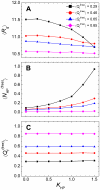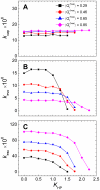Nonnative interactions in coupled folding and binding processes of intrinsically disordered proteins
- PMID: 21079758
- PMCID: PMC2973977
- DOI: 10.1371/journal.pone.0015375
Nonnative interactions in coupled folding and binding processes of intrinsically disordered proteins
Abstract
Proteins function by interacting with other molecules, where both native and nonnative interactions play important roles. Native interactions contribute to the stability and specificity of a complex, whereas nonnative interactions mainly perturb the binding kinetics. For intrinsically disordered proteins (IDPs), which do not adopt rigid structures when being free in solution, the role of nonnative interactions may be more prominent in binding processes due to their high flexibilities. In this work, we investigated the effect of nonnative hydrophobic interactions on the coupled folding and binding processes of IDPs and its interplay with chain flexibility by conducting molecular dynamics simulations. Our results showed that the free-energy profiles became rugged, and intermediate states occurred when nonnative hydrophobic interactions were introduced. The binding rate was initially accelerated and subsequently dramatically decreased as the strength of the nonnative hydrophobic interactions increased. Both thermodynamic and kinetic analysis showed that disordered systems were more readily affected by nonnative interactions than ordered systems. Furthermore, it was demonstrated that the kinetic advantage of IDPs ("fly-casting" mechanism) was enhanced by nonnative hydrophobic interactions. The relationship between chain flexibility and protein aggregation is also discussed.
Conflict of interest statement
Figures

 = 0.29, 0.46, 0.65, and 0.85 by tuning the intramolecular interaction parameter α from 0.1, 1.0, 1.5 to 3.0. The two vertical dashed lines in panel (B) indicate the definition of the unbound state (U), intermediate state (I), and bound state (B). The strength of the nonnative hydrophobic interactions (K
HP) ranges from 0.00 to 1.50.
= 0.29, 0.46, 0.65, and 0.85 by tuning the intramolecular interaction parameter α from 0.1, 1.0, 1.5 to 3.0. The two vertical dashed lines in panel (B) indicate the definition of the unbound state (U), intermediate state (I), and bound state (B). The strength of the nonnative hydrophobic interactions (K
HP) ranges from 0.00 to 1.50.

 ), and (C) the average fraction of native contacts (
), and (C) the average fraction of native contacts ( ).
).
 along the binding process when the strength of nonnative hydrophobic interactions was increased: (A–C) K
HP = 0.50, 1.00, and 1.50. (D) Correlation between the average number of nonnative contacts at the intermediate state
along the binding process when the strength of nonnative hydrophobic interactions was increased: (A–C) K
HP = 0.50, 1.00, and 1.50. (D) Correlation between the average number of nonnative contacts at the intermediate state  and
and  . K
HP was set 1.50. (E) Correlation between the average number of nonnative contacts in the bound state
. K
HP was set 1.50. (E) Correlation between the average number of nonnative contacts in the bound state  and
and  . K
HP was set 1.50. (F) Correlation between
. K
HP was set 1.50. (F) Correlation between  and K
HP. The definitions of the intermediate state and bound state are presented in Figure 1.
and K
HP. The definitions of the intermediate state and bound state are presented in Figure 1.
 . (C) Correlation between the K
HP corresponding to the maximum binding rate, K
HP
max-rate, and
. (C) Correlation between the K
HP corresponding to the maximum binding rate, K
HP
max-rate, and  . (D) A typical binding trajectory for the system with
. (D) A typical binding trajectory for the system with  = 0.46 under K
HP = 1.50.
= 0.46 under K
HP = 1.50.


 . Contact distance σhϕ = 7.5 Å was used in (A–C). (D) The sensitivity of the binding rate with respect to nonnative hydrophobic interactions for σhϕ = 5.0 and 7.5 Å.
. Contact distance σhϕ = 7.5 Å was used in (A–C). (D) The sensitivity of the binding rate with respect to nonnative hydrophobic interactions for σhϕ = 5.0 and 7.5 Å.Similar articles
-
Free-energy landscape of intrinsically disordered proteins investigated by all-atom multicanonical molecular dynamics.Adv Exp Med Biol. 2014;805:331-51. doi: 10.1007/978-3-319-02970-2_14. Adv Exp Med Biol. 2014. PMID: 24446368
-
Insights into Coupled Folding and Binding Mechanisms from Kinetic Studies.J Biol Chem. 2016 Mar 25;291(13):6689-95. doi: 10.1074/jbc.R115.692715. Epub 2016 Feb 5. J Biol Chem. 2016. PMID: 26851275 Free PMC article. Review.
-
Mechanism of coupled folding and binding of an intrinsically disordered protein.Nature. 2007 Jun 21;447(7147):1021-5. doi: 10.1038/nature05858. Epub 2007 May 23. Nature. 2007. PMID: 17522630
-
Kinetic advantage of intrinsically disordered proteins in coupled folding-binding process: a critical assessment of the "fly-casting" mechanism.J Mol Biol. 2009 Nov 13;393(5):1143-59. doi: 10.1016/j.jmb.2009.09.010. Epub 2009 Sep 10. J Mol Biol. 2009. PMID: 19747922
-
[Intrinsically disordered protein and encounter complex].Tanpakushitsu Kakusan Koso. 2007 Aug;52(9):945-51. Tanpakushitsu Kakusan Koso. 2007. PMID: 17684948 Review. Japanese. No abstract available.
Cited by
-
Explicit Characterization of the Free Energy Landscape of pKID-KIX Coupled Folding and Binding.ACS Cent Sci. 2019 Aug 28;5(8):1342-1351. doi: 10.1021/acscentsci.9b00200. Epub 2019 Jul 15. ACS Cent Sci. 2019. PMID: 31482116 Free PMC article.
-
Insights into the Binding of Intrinsically Disordered Proteins from Molecular Dynamics Simulation.Wiley Interdiscip Rev Comput Mol Sci. 2014 May-Jun;4(3):182-198. doi: 10.1002/wcms.1167. Epub 2013 Aug 27. Wiley Interdiscip Rev Comput Mol Sci. 2014. PMID: 34354764 Free PMC article.
-
Electrostatically accelerated coupled binding and folding of intrinsically disordered proteins.J Mol Biol. 2012 Oct 5;422(5):674-684. doi: 10.1016/j.jmb.2012.06.019. Epub 2012 Jun 19. J Mol Biol. 2012. PMID: 22721951 Free PMC article.
-
Expanding the proteome: disordered and alternatively folded proteins.Q Rev Biophys. 2011 Nov;44(4):467-518. doi: 10.1017/S0033583511000060. Epub 2011 Jul 1. Q Rev Biophys. 2011. PMID: 21729349 Free PMC article.
-
Advantages of proteins being disordered.Protein Sci. 2014 May;23(5):539-50. doi: 10.1002/pro.2443. Epub 2014 Mar 17. Protein Sci. 2014. PMID: 24532081 Free PMC article. Review.
References
-
- Dill KA, Chan HS. From Levinthal to pathways to funnels. Nat Struct Biol. 1997;4:10–19. - PubMed
-
- Bryngelson JD, Onuchic JN, Socci ND, Wolynes PG. Funnels, pathways, and the energy landscape of protein folding: a synthesis. Proteins. 1995;21:167–195. - PubMed
-
- Ueda Y, Taketomi H, Gō N. Studies on protein folding, unfolding, and fluctuations by computer simulation. II. A. three-dimensional lattice model of lysozyme. Biopolymers. 1978;17:1531–1548.
-
- Gō N. Theoretical studies of protein folding. Annu Rev Biophys Bioeng. 1983;12:183–210. - PubMed
Publication types
MeSH terms
Substances
LinkOut - more resources
Full Text Sources

